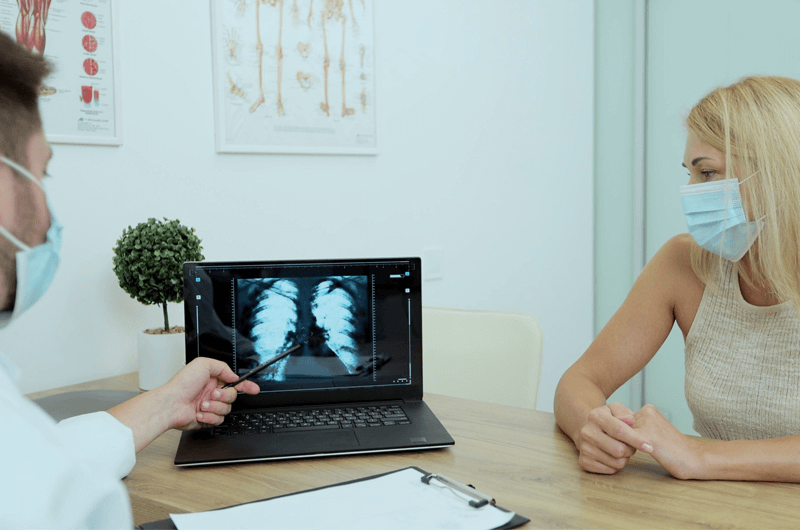Providers can use the new HCPCS code – S8032 recently released by CMS for medical billing purposes when reporting low-dose CT for lung cancer screening. Lung cancer is considered the second most common cancer in the United States affecting both men and women. According to the American Cancer Society’s 2014 estimates, about 224,210 new cases of lung cancer (116,000 in men and 108,210 in women) are reported in the United States. This condition mainly occurs in older people. Reports suggest that about 2 out of 3 people diagnosed are 65 years or older.
Generally, the symptoms of this disease do not appear until it reaches its advanced stages. In certain cases, even if some symptoms do appear, many patients may mistake them for other problems such as infections, problems related to smoking and so on. This in turn may cause delay in diagnosis.
For early detection of the disease, oncologists recommend regular and standard screening tests. These routine tests will help patients to better manage the cancer symptoms thereby enhancing patient function. In addition, it will help to determine the correct treatment modality as well.
Physicians may conduct a comprehensive diagnostic evaluation of the symptoms by conducting different tests such as computed tomography (CT) scan, chest X-rays, bronchoscopy, sputum cytology and fine-needle aspiration (FNA) biopsy of the lung. These tests help to identify the disease in its early stages and begin treatment in order to reduce the chances of complications.
Oncologists while administering different treatment modalities should have up-to-date knowledge about the latest guidelines or practices for medical billing and coding. Accurate diagnostic and procedural codes are to be reported on the claims to receive correct reimbursement.
CMS Approves Medicare Coverage for CT Lung Cancer Screening
The Centers for Medicare & Medicaid Services (CMS) has issued a formal proposal approving annual low-dose computed tomography (CT) lung cancer screening for high-risk individuals until the age of 74 years. The new proposal is considered as a bold move and is regarded as one of the most predominant cancer mortality reduction efforts till date. The current proposal is now open for a 30-day comment period.
The new code addition is in response to the U.S. Prevention Services Task Force (USPSTF) approving annual lung cancer screening with low-dose CT for individuals at high risk for cancer.
CT scan is regarded as the most effective test that helps to detect the disease symptoms in its early stages thereby considerably reducing the total number of deaths. As per CMS guidelines, low dose CT would be reimbursed annually for those beneficiaries who are eligible under the criteria of pivotal National Lung Screening Trial (NLST). The main highlights of the new proposal includes –
- Patients can undergo CT scanning tests only after attending a mandatory lung cancer screening following a counseling and shared decision-making visit with a physician. Individuals must be between 55 – 74 years of age to become eligible for the same.
- Patients need to be asymptomatic with no signs or symptoms of chronic lung disease, should have a smoking history of at least 30 pack-years and should either smoke currently or have quit the same within the past 15 years.
However, there are certain additional criteria as well. In order to undergo an initial scanning, the beneficiary should obtain a written order during counseling and shared decision making visit either from a physician, nurse assistant or clinical nurse specialist.
In addition, there are separate rules or eligibility criteria for radiologist and imaging centers. It is essential that radiologists are board-certified, accredited and experienced in this area to perform the same. The imaging centre should have participated in the NLST (National Lung Screening Trial) and should be an accredited center with experience in performing low-dose CT scan.
Many private health insurers provide coverage for lung cancer screening. Under the Affordable Care Act (ACA) private insurers will be required to cover the U.S. Preventive Services Task Force (USPSTF) screening (including low-dose CT lung cancer scans) without cost-sharing beginning January 1, 2015. However, those people under Medicare would have to pay for the same fully out-of-pocket if CMS had denied coverage for the scan.
CT Lung Cancer Screening May Benefit More People – Finds Study
A new study published online (August 28, 2014 issue) in the Journal of the American College of Radiology reports that computed tomography (CT) lung cancer screening may potentially benefit more number of people (than previously thought) and that the test can be made more effective by using the ACR lung imaging reporting and data system to classify the patient exams. The findings were made as part of two different studies conducted.
As part of the first study, researchers analyzed data from Lahey Hospital and Medical Center in Burlington, MA. They studied data to verify whether the lung CT scans would help patients with additional risk factors outside the criteria recommended by the National Lung Screening Trial (NLST). A 20% mortality benefit for CT scans of high-risk smokers (current or former smokers aged between 55-70 years with smoking history of 30 years or more) was reported.
Researchers used moderate screening guidelines from the National Comprehensive Cancer Network (NCCN). This essentially covered smokers with 20 pack-year smoking histories who had suffered at least one prominent lung cancer risk factor namely family history of other cancers or any other chronic lung disease. However, this excluded exposure to second-hand smoke. In addition, the NCCN criteria lowered the test age as 50 years.
Researchers compared a total of 1760 patients screened in both NCCN and NLST studies starting from January 2012 to December 2013. The rate of annualized cancer detection was reported 1.8% in the NCCN group and 1.6% in the NLST group. The study findings signify that expanding screening programs by including patients with additional risk factors will help detect more cancers and save additional lives every year.
In the second study, researchers assessed the effect of using the Lung-RADS (a quality assurance tool to standardize screening). They classified the CT exams of 2,180 patients who were at high risk of this disease using ACR Lung-RADS. It was found that using Lung-RADS helped to reduce the positive rate from 27.6% to 10.6%. In addition, it increased the positive predictive value for diagnosed malignancy from 6.9% to 17.3%.
Lung cancer is a deadly disease that doesn’t start causing signs and symptoms until it gets spread fully. Reports from the American Cancer Society suggest that more than 160,000 deaths occur each year in the US due to this disease. Implementation of annual scans can help improve outcomes through early detection and also reduce treatment costs. Research shows that low-dose CT scans for individuals at high-risk for lung cancer could potentially save up to 20,000 lives per year.
Medicare coverage CT lung cancer screening for high-risk individuals provides access to care for seniors and will allow physicians to save thousands of lives each year. Hence, it is important for senior current and former smokers to discuss with their physicians to determine whether CT lung cancer scanning is right for them.




